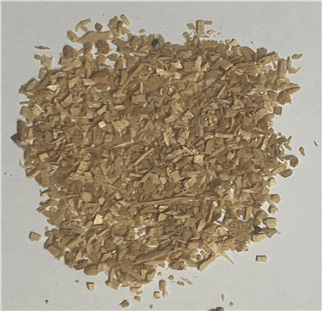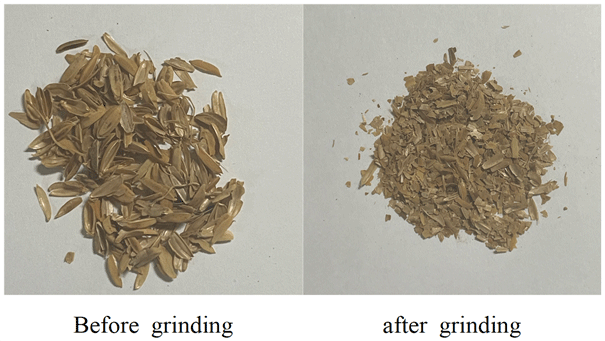1. INTRODUCTION
Nowadays, most of the modern life takes place indoors and so, interest in wood and wood materials, which are eco-friendly building materials, is increasing according to problems related to the indoor environment and personal health problems. Accordingly, it is necessary to cope with the situation of increasing consumption of wood and wood materials, developing a stable supply of wood materials and alternative materials for scarce wood resources. Especially, in terms of environmental issues and resource conservation, the recycling and technological development of wood waste and agricultural waste is important, so research and development for new wood composite materials is becoming active (Hwang et al., 2020; Hwang et al., 2019; Prabuningrum et al., 2020; Jamaludin et al., 2020; Kang et al., 2019; Ju and Roh, 2019; Ju and Roh, 2020; Jung et al., 2020; Kang et al., 2019).
Among them, sawdust, by-product generated during log processing, usually produced around 10% volume ratio of the log (There could be a difference depending on the thickness of the log and the dimensions of the log). According to the Korea 2020 Forestry Statistical Yearbook, sawdust was produced in 2019 at 128,817㎥, KRW 19.9 billion. In accordance with the classification and recycling standards of waste wood in the Korea Ministry of Environment's Notice (Ministry of Environment Notice No. 2008 - 147), it is classified as Grade 1 and can be recycled as wood molded products. However, most of them are used as fuel for firewood, for manure treatment in livestock farms, mushroom cultivation, etc., and limitedly pulverized to be used for plastic molding, fiber wall materials and activated carbon manufacturing. In addition, rice husk, an agricultural waste, generates about 1.1 million tons of rice husk annually in Korea, weighing 20-25% of rice production. Also, its large volume with an apparent density of 0.097~0.125 g/㎤ has a problem when discard. Moreover, due to its low calorific value and high ash content, it has the disadvantage of not being easily decomposed even after buried, so it has been mainly used as agricultural compost and desiccant for pigsty (Baek et al., 1998; Kim et al., 2001). The technology development of wood materials using sawdust and rice husks has been studied in various ways.
In addition, wood materials, which were made only of existing wood materials, are gradually changing to eco-friendly materials in which functional materials are mixed. Research and development of various eco-friendly materials considering durability and functionality are being carried out (Park et al., 2011, 2012, 2013; Ahn, 2009). Among them, charcoal is a representative eco-friendly material that can be easily accessed, and although it varies depending on the manufacturing method, carbon usually accounts for about 80 to 90% of content, and is a complex carbonaceous polymer material containing oxygen, hydrogen and ash. The specific gravity of charcoal is about 0.6-0.9, and it shows alkalinity with a pH of 8-9 (Seo, 2014). In addition, it has a very large specific surface area of about 100~300 ㎡ per 1 g of weight, and it is porous, so it has excellent adsorption power, so it has been used for various purposes such as air purification, deodorization, and protection from poison since ancient times. In addition, charcoal is easy to obtain, and has various functions such as deodorizing, working as a preservative, filtering, moisturizing, anion generating, and electromagnetic wave blocking performance have been highlighted, resulting in increased production and demand. So recently, a lot of research is being conducted as an important raw material for eco-friendly material research (Park et al., 2011, 2012, 2013; Ahn, 2009; Park and Park, 2011; Kim, 2017; Hwang and Oh, 2017, 2020a, 2020b).
Therefore, in this study, to examine the use of charcoal, sawdust, and rice husk, which are eco-friendly functional materials, mixed boards were manufactured by density and mixing ratio, and bending performance was measured.
2. MATERIALS and METHODS
Sawdust we used was made when sawing larch (Larix kaemferi C.) cut down by thinning and we purchased from a commercial sawmill. As shown in Fig. 1, using a sorter (Shinchang co., vibrator), it was selected at -18 mesh, and the moisture content was adjusted to 6% or less.
The rice husks were purchased from a rice mill in Deokjin-dong, Jeonju, and dried in the shade. As shown in Fig. 2, in order to increase the bonding strength when manufacturing the board, it was pulverized with a pulverizer (Hanshin co., J-NCM), the particle size was selected as -18 mesh, and the moisture content was adjusted to 6% or less.
Oak charcoal was purchased and used in -100mesh size from Geumhan Farm Co., Ltd. in Imsil.
Due to the characteristics of the thermo-presser used for manufacturing, it has a disadvantage in that it is difficult to discharge moisture, so a powdered phenolic resin (Kolon Petrochemical Co., Ltd., KNB-100PL) was used to manufacture the board, and the characteristics of the resin are shown in Table 1.
| Resin types | Powder resin (novolak type) |
|---|---|
| Items | |
| Solid content (%) | 99 |
| Melting point (℃) | 80~95 |
| Gelation time (sec.) | 80~120 |
| Plate flow (mm) | 30~35 |
As for the manufacturing conditions of the board, the resin addition ratio was fixed at 10% of the total weight, the density was fixed at 0.6 g/㎤, and the addition amount of sawdust, rice husk and charcoal was varied to 50:35:5, 50:30:10, 50:25:15, and 50:20:20 to prepare 4 types. The amount of sawdust, rice husk and charcoal was fixed at 50:20:20 and the density was set to 3 types of 0.5, 0.6, 0.7 g/㎤. Uniformly selected sawdust, rice husk and charcoal was sufficiently mixed with the powdered phenolic resin and it was placed in a mold on the hot plate of a thermo-presser (Daeyang Machinery, DYMSP-001-026), the height of the upper part of the sample was adjusted to a certain level, and then a board of 260 mm × 260 mm × 11 mm was manufactured by thermo-press molding. At this time, the temperature was set to 170°C, and the pressure was 40 kgf/㎠ → 30 kgf/㎠ → 20 kgf/㎠ (three-stage pressurization), 9 minutes → 2 minutes → 1 minutes (three-stage pressurization time). A thickness bar was used to make the thickness of the board constant during the hot-pressing process, and a Teflon plate was used to prevent adhesion of the top and bottom of the board to the hot plate due to heat. Fig. 3 is a picture of the finished board.
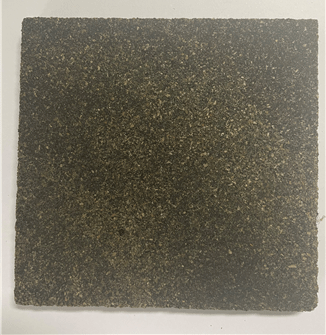
An accelerometer (B&K) for vibration reception was attached to the center of the specimen, and one end was lightly tapped with an impact hammer (Type 8203, B&K) to obtain a frequency response function from the impact hammer and accelerometer. With this, the natural frequency (f0) was measured by using a signal analyzer (FFT analyzer, Type 3065, B&K). Each test piece was tapped 5 times, and the average natural frequency (f0) was used to calculate the resonance frequency (f) considering the rotational inertia and shear effect, and the dynamic modulus of elasticity (dMOE) was calculated using this resonance frequency. The standard of the test piece used for the test was measured by selecting 8 pieces for each condition using the bending strength test piece specified in Korean Industrial Standard KS F 3104-2006.
The bending strength and static bending modulus of the manufactured board were selected for 8 each condition and carried out according to the Korean Industrial Standards KS F 3104-2006. It was measured at a load speed of 10 mm/min using a universal strength tester (Shimadsu, AGS-10 kN, Autograph).
3. RESULTS and DISCUSSION
Table 2 shows the measured values of the resonant frequency, bending strength, static bending modulus and dynamic modulus of elasticity (One of the non-destructive test methods that do not change the performance of the end-use of the material) of boards manufactured by density with the addition ratio of sawdust, rice husk and charcoal as 50:20:20 with the 10% of resin addition ratio. As the density of the board made of sawdust, rice husk and charcoal increases from 0.5 g/cm3 to 0.7 g/cm3; the resonant frequency increases from 102.2Hz to 268.3Hz, Bending strength increases from 0.42 MPa to 3.24 MPa, the dynamic modulus of elasticity increases from 888.4 MPa to 94.5 MPa, the static modulus of elasticity increases from 31.4 MPa to 220.7 MPa. In determining the mechanical properties of the board, the density of the board is an important determining factor, and in general, the mechanical properties increase as the density of the board increases. As the density increases, the amount of crushed sawdust, rice husk and charcoal increases. As the density increases, the amount of sawdust and rice husk in particle form increases more than the amount of charcoal powder. Therefore, when the molded mat is pressed, it is thought that the higher the density of the board, the denser the spacing and structure between the particles of the board, thereby strengthening the bonding force and thus the bending performance is increased. Also, Oh (2003) reported that the bending strength increased as the density of sawdust boards made of sawdust from the Trees cut down after thinning increased, and Piao (2004) reported that the bending strength increased rapidly as the density of mixed boards made of sawdust and rice husks increased. Also, Jin et al. (2015) reported that the bending performance increased as the density of boards made of sawdust and orange peel increased.
On the other hand, each correlation with the board density and bending strength, the resonant frequency, the dynamic modulus of elasticity and the static bending modulus of elasticity was analyzed to determine the effect on the strength performance of each density of the board manufactured with the raw material ratio of sawdust, rice husk and charcoal as 50:20:20 with the resin addition rate as 10%. The result is shown in Fig. 4. The coefficient of determination (R2) between the sawdust addition ratio, bending strength, and dynamic and static bending modulus of elasticity showed a correlation of 0.6400, 0.7733, 0.7187, and 0.7660, respectively. This was found to be significant at the significance level of 1%, and it was found that the density was a major factor affecting the bending performance of the mixed board.
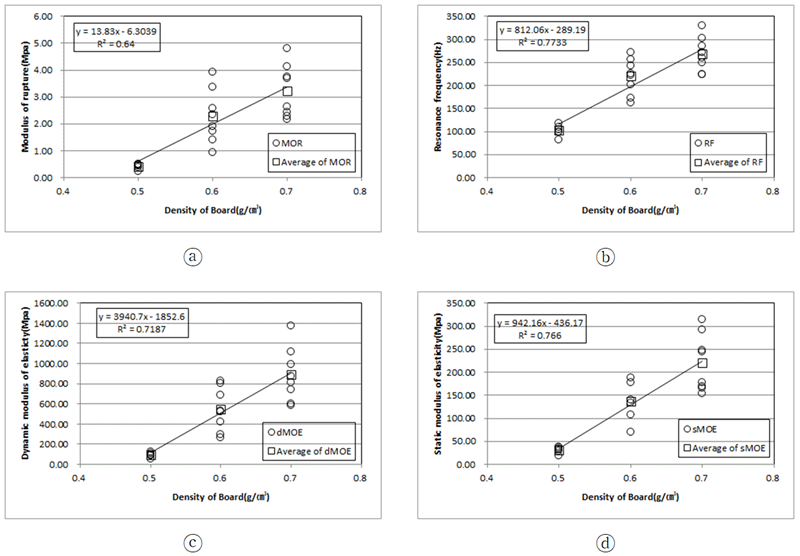
Table 3 shows the values of the resonant frequency, bending strength, static bending modulus of elasticity, and dynamic modulus of elasticity of a board manufactured with a sawdust addition rate of 50% and Manufactured at a density of 0.6 g/㎤ by varying the addition ratio of rice husk and charcoal. When the charcoal addition ratio among the rice husk and charcoal addition ratios of the mixed board is increased from 5 to 20%, the resonance frequency had a range of 295.39~205.02Hz, the bending strength was 4.69~ 1.81 MPa, the dynamic modulus was 1026.45~456.31 MPa, and the static modulus of elasticity was in the range of 361.15 to 136.13 MPa. Overall, the resonant frequency, bending strength, dynamic modulus of elasticity and static modulus of elasticity tend to decrease as the addition ratio of rice husk decreased and the addition ratio of charcoal increased. This is considered to be the result of weakening the internal bonding force by reducing the amount of compaction during board manufacturing when the addition ratio of rice husk in the particle state is less than the amount of charcoal in the powder state. Park et al. (2007) found that the strength decreased as the amount of carbide added increased in the physical properties of particleboards made from waste wood carbide. This showed a trend similar to the result reported that the strength of the carbide itself was weaker than that of the particles and directly affected the internal bonding strength. Also, Park et al. (2013) reported that the overall bending strength tends to decrease as the mixing ratio of green tea and charcoal in composite boards made of green tea, charcoal, and wood fibers increases.
Meanwhile, In order to understand the effect of the addition ratio of a board manufactured with a density of 0.6 g/cm3 by varying the addition ratio of rice husk and charcoal with the addition ratio of sawdust fixed at 50%, the correlation between the bending strength, resonance frequency, dynamic modulus of elasticity and static bending modulus according to the addition ratio of rice husk and charcoal was analyzed. And the results are shown in Fig. 5. The coefficient of determination (R2) between the addition ratio of rice husk and charcoal, bending strength, resonance frequency, and dynamic and static bending modulus were 0.4562, 0.4310, 0.4589, and 0.5847, respectively. It showed a rather low correlation, and it was found that the effect of the addition ratio on the bending performance was negligible. In the case of a composite material using two or more raw materials, it is judged that the correlation is somewhat irregular due to the difference in density and adhesion between the raw materials and the deviation generated in the process of mixing the raw materials (Park et al., 2011; Park et al., 2013; Jin et al., 2015).
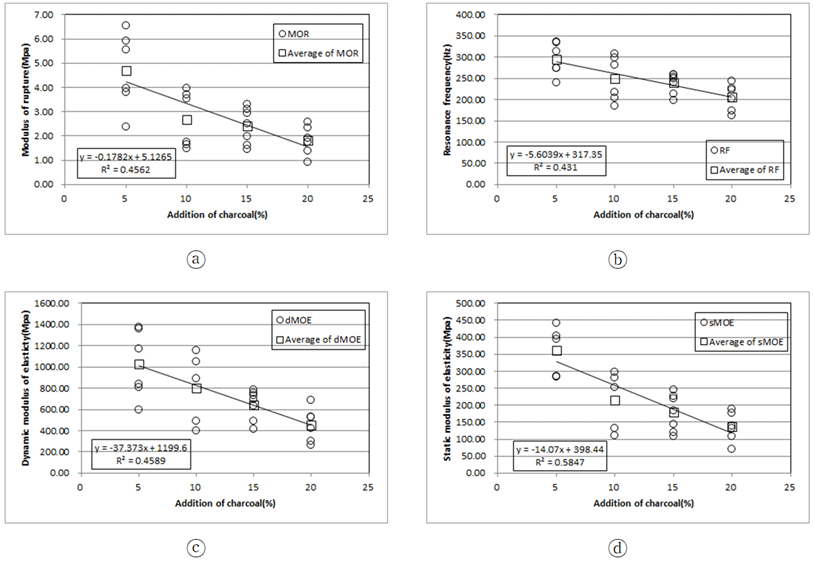
4. CONCLUSION
In this study, an environmentally friendly material, charcoal, was added to rice husk, an agricultural by-product, and sawdust generated in the cutting logs process, and the board was manufactured according to the mixing ratio and density of rice husk and charcoal. And the following results were obtained by examining the physical and mechanical properties for use development.
As the density increases from 0.5 g/㎤ to 0.7 g/㎤, the bending strength is 0.42 to 3.24 MPa, the dynamic modulus of elasticity is 94.5 to 888.4 MPa, and the static modulus is in the range of 31.4 to 220.7 MPa, From this, it was confirmed that the bending performance increased as the density increased, so that the density had a significant effect on the bending performance.
In the boards manufactured by the addition ratio of rice husk and charcoal, the bending performance showed a tendency to decrease as the addition ratio of charcoal increased. However, as for the relationship between the addition ratio of rice husk and charcoal, bending strength, resonance frequency, and dynamic and static bending elastic modulus, the values of the coefficient of determination (R2) were 0.4562, 0.4310, 0.4589, and 0.5847, respectively, indicating a rather low correlation. It was found that the effect of the addition ratio on the bending performance was small.
The bending performance of the composite board did not satisfy the quality standards of KS F 3104 particle board. To improve the strength performance so that it can be used as an indoor building material in the future, it is judged that a follow-up experiment is necessary with a detailed density condition and a material addition ratio condition. In addition, for practical use, research on thermal insulation and adsorption properties is required in consideration of the material properties of composite boards.









